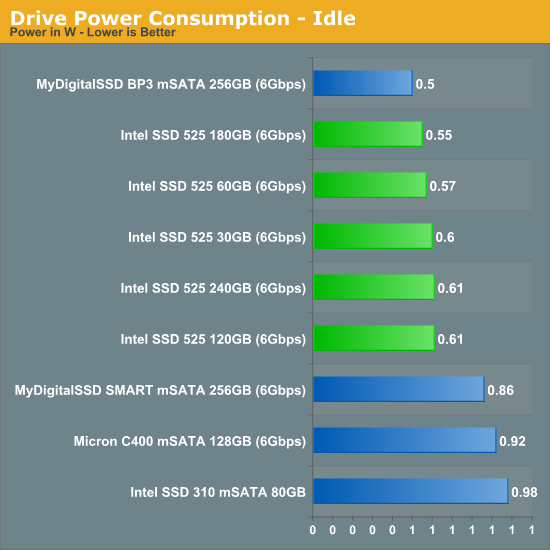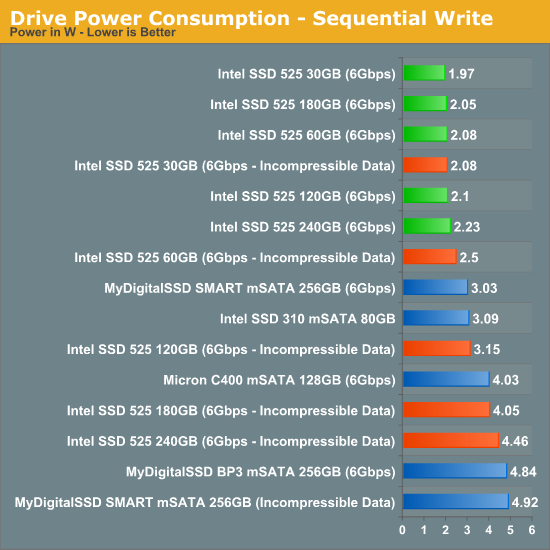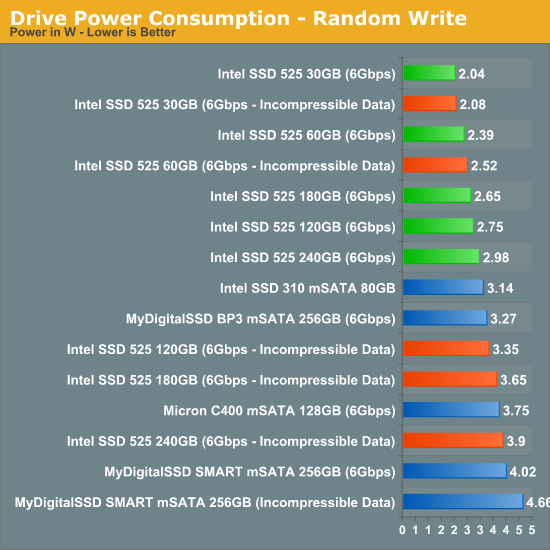The Full Intel SSD 525 Review: 30GB, 60GB, 120GB, 180GB & 240GB Tested
by Anand Lal Shimpi on February 3, 2013 2:30 AM EST- Posted in
- Storage
- SSDs
- Intel
- SandForce
- Intel SSD 520
- Intel SSD 525
TRIM Functionality
SandForce has always exhibited strange behavior when it came to TRIM. Even Intel's custom firmware in the SSD 520 wasn't able to fix SandForce's TRIM problem. The issue happens when the SSD is completely filled with incompressible data (both user LBAs and spare area). Any performance degradation after that point won't be restored with a TRIM pass and instead will require a secure erase to return to new. None of the Intel SF SSDs have been able to fix this issue and the 525 is no exception. I ran a slightly modified version of our usual test here. I filled the drive with incompressible data, ran our consistency workload (also with incompressible data) then measured performance using a 128KB (incompressible) pass in IOmeter. I then TRIMed the entire drive and re-ran the IOmeter test.
| Intel SSD 525 Resiliency - IOMeter 128KB Incompressible Sequential Write | |||||
| Clean | After Torture (30 mins) | After TRIM | |||
| Intel SSD 525 240GB | 293.5 MB/s | 59.8 MB/s | 153.3 MB/s | ||
And the issues persists. This is really a big problem with SandForce drives if you're going to store lots of incompressible data (such as MP3s, H.264 videos and other highly compressed formats) because sequential speeds may suffer even more in the long run. As an OS drive the SSD 525 will do just fine since it won't be full of incompressible data, but I would recommend buying something non-SandForce if the main use will be storage of incompressible data.
Power Consumption
In our original 525 review I noticed lower idle power consumption compared to the Intel SSD 520, however higher active power consumption. It turns out that both active and idle power consumption should be lower than the 520. As is the case with all of our SSD reviews, we measure power consumption on the 5V rail going into the drive as most drives don't use 3.3V or 12V power. In the case of the 525, it will draw power on the 3.3V rail by default but when used in our mSATA to SATA adapter it is only fed power on the 5V rail. Measuring power at the mSATA to SATA adapter rather than at the mSATA board itself is likely the cause for this discrepancy. Update: We've measured 525 power consumption using the 3.3V rail supplied directly to the drive.
The numbers below are taken from drives using the same mSATA adapter, although actual power consumption in a system with a native mSATA connector should be lower for the 525 at least. Note that the 180GB 525 only has three NAND packages, which seems to positively influence power consumption in the easily compressible data access tests. Under incompressible data load the extra NAND die outweigh the power savings of only having three NAND packages.
Power consumption remains a strength of the 525, although I'd be curious to see how an mSATA Samsung 840 Pro would do here.













26 Comments
View All Comments
Shadowmaster625 - Monday, February 4, 2013 - link
So intel is serious about ultrabooks? Their actions seem to prove otherwise.That SSD controller should be integrated into all their i-series cpus. Windows is slow and unwieldy in large part due to intel not providing an efficient nonvolatile storage platform. If every windows installation had guaranteed access to even a small amount of fast nonvolatile memory, then maybe we would see less cpu cycles wasted moving data around from HDD to RAM to another part of RAM and then back to HDD then back to RAM 50 million times.
FunBunny2 - Monday, February 4, 2013 - link
Here's what Linus said back in 2007:... but Flash-based storage has such a different performance profile from rotating media, that I suspect that it will end up having a large impact on filesystem design. Right now, most filesystems tend to be designed with the latencies of rotating media in mind.
melgross - Monday, February 4, 2013 - link
I don't understand why mSATA drives seem to cost more than regular drives. Most drives come in an aluminum case, which isn't cheap to make, plus the assembly that's then required. I would think that these, being just chips on a circuit board, without even the soldered on sockets a regular drive has, would be a good 10% less, not more.mcnabney - Monday, February 4, 2013 - link
Manufacturing cost frequently has little to do with MSRP.An obvious example of cheaper to produce media selling for more would be compact disks and DVDs versus their predecessors using magnetic tape. The digital media had a significant upcharge despite production costs being significantly lower.
DanNeely - Monday, February 4, 2013 - link
Probably lower sales volumes. Even if the total sales volumes (and marginal development cost per unit) are similar, relatively few consumers are buying mSata vs 2.5" models. This results in less competition between retailers to push margins down and higher expenses for the same (because of the longer time periods between when they buy and sell the devices that their purchase costs have to be covered by borrowing).melgross - Monday, February 4, 2013 - link
Manufacturers will be the main customers for these drives. But price also determines sales volume. Price them too high and volume drops. There couldn't have been too much extra R&D on these, as they are basically the same as drives inside a case. The small circuit boards cost little to design and manufacturer, and Intel is paying the same thing for the chips.RU482 - Monday, February 4, 2013 - link
good to see that newegg is off to some early profiteering with the 120GB version on sale at $169.99philipma1957 - Monday, February 4, 2013 - link
Simple make a mobo that runs them at sata III speeds. I have yet to find one.A small form itx with a 480gb crucial m500 running at full sata III would be a reason to buy a mSata.
I really quite a bit frustrated as this block to my build in the coolermaster elite 120 cases. the case allows
an i7 3770k
a full sized psu
a full sized bluray
a full sized hd7970
the better itx mobos have a msata slot that boots but they are sata II.
it is a real shame as this case allows for high over clock speeds with easy mods.
you can have an almost perfect one card machine with the msata ssd.
you can fit a 2.5 inch sata ssd so you can have a very powerful machine but a power wire a sata wire and the drive case itself do make the case more crowded.
Jaseemxx91 - Monday, February 4, 2013 - link
Can anybody tell me if this will fit inside my Ux31e Ultrabook?Anand have said that it has a different port than that of an Mac book Air here
www.anandtech.com/show/5854/asus-zenbook-ssd-and-apples-macbook-air-ssd-are-not-compatible
My Zenbook ssd is dead, and i dont know which one to get, that is compatible in my system.
Could somebody help me with this?
I would really love an Answer from Anand himself, as he has already seen and inspected the Connector himself. But as i am not So Lucky guy, i dont really think Anand would even read this :/
Btw, Congrats on this extremelY informative Site of yours. Keep up the Great Work. :)
Death666Angel - Monday, February 4, 2013 - link
Asus uses a proprietary connector as well, so any off the market mSATA drive will not work. Look for specific UX31 drives. Email ASUS, they should be able to provide you with information and maybe even a replacement (for free or for money). If you want to reach Anand directly, try Twitter. :)